Iron usually shows up as reddish-brown stains in your tubs and on your faucets, and while it isn’t dangerous, it can cause problems around your home.
We’re experts in treating drinking water supplies, and we’ve tried and tested all the best methods to reduce or eliminate iron from well water. We’ve shared those worth knowing about here.
📌 Key Takeaways
- The best way to remove ferrous iron from well water is with an ion exchange water softener.
- Top methods of removing both ferrous and ferric iron include air injection/oxidation systems, chlorine or other chemical injection systems, and birm and manganese greensand filtration.
- The best way to remove ferric iron (rust) from well water is with a sediment filter.
- Shock chlorination is the most effective method of targeting iron bacteria.
| Method | Type of Iron Removed | Iron Reduction (PPM) | Best For |
|---|---|---|---|
| Ion Exchange Water Softeners | Ferrous | 5-10 | Well water with low iron levels and hardness |
| Air Injection Iron Filter | Ferrous & Ferric | Up to 30 | High iron levels, chemical-free oxidation |
| Chlorine Injection Iron Filter | Ferrous & Ferric | Up to 30 | High iron levels, disinfection |
| Ozone Water Treatment | Ferrous & Ferric | Up to 30 | High iron levels, disinfection, bacteria control |
| Hydrogen Peroxide Oxidation | Ferrous & Ferric | Up to 30 | High iron levels, instant oxidation |
| Potassium Permanganate Solution | Ferrous & Ferric | Up to 10 | Low iron levels, simple chemical method |
| Polyphosphate Sequestering | Ferrous & Ferric (best for ferrous) | 3-4 | Aesthetic problems caused by iron |
| Birm | Ferrous & Ferric | 10-15 | Air injection iron filters, natural media |
| Manganese Greensand | Ferrous & Ferric | 10-15 | Chemical-free iron and manganese removal |
| Katalox, Filox, & Pyrolox | Ferrous & Ferric | 10-15 | Chemical-free iron removal |
| KDF Filters | Ferrous & Ferric | 4-6 | Low iron levels, cartridge-based |
| Sediment Cartridge Filters | Ferric | Up to 6 | Ferric iron (rust) in low concentrations |
| Shock Chlorination | Bacterial Iron | Up to 100% | Iron bacteria contamination |

Table of Contents
- 🔂 Ion Exchange Water Softeners
- 📥 Air Injection Iron Filter
- 🚰 Chlorine Injection Iron Filter
- 🪞 Ozone Water Treatment
- 🧴 Hydrogen Peroxide Oxidation
- 🧮 Potassium Permanganate Solution
- 🔮 Polyphosphate Sequestering
- ⚗️ Birm
- 🈯️ Manganese Greensand
- 💠 Katalox, Filox, & Pyrolox
- 🔅 KDF Filters
- 📇 Sediment Cartridge Filters
- 🌀 Shock Chlorination
- 🧠 How to Remove Iron From Water: FAQ
🔂 Ion Exchange Water Softeners
Type of iron removed: Ferrous iron
Iron reduction rate: 5-10 PPM
Whole-house water softener systems don’t just remove hardness-causing minerals like calcium and magnesium. Many are also effective at removing iron.
You can buy a whole house salt-based water softener that will treat well water at its point of entry into your home.
How it Works
Water softeners use a process known as ion exchange on a charged resin bed. During the ion exchange process, dissolved calcium and magnesium ions bind to the water softener resin, which releases equal amounts of sodium (salt) ions to balance the water’s charge.
This produces salt-softened water, and the unwanted ions are flushed away from the resin when the water softener regenerates.
Using this same process, water softeners also remove low levels of clear water iron present in a hard water supply.
💡 Tip: to facilitate iron removal, increase your water hardness setting by 3 GPG for every 1 PPM of iron detected in your water.
Too much iron could foul the resin in a water softener, so this method is only suitable if your water’s iron levels are lower than 3 PPM.
The Evidence
- This 2017 review on the strategies to remove iron from water cites ion exchange as one of the most commonly used iron removal methods, although it doesn’t note how much iron can be removed using this technique.
- A University of Nebraska-Lincoln report noted that some water softeners could remove up to 5-10 PPM of iron and manganese, commenting that special water softener salts may be used containing citric acid, which are specifically designed to manage iron.
Best For
Folks who want to remove low levels of ferrous iron as well as softening their well water supply.

📥 Air Injection Iron Filter
Type of iron removed: Ferrous & ferric iron
Iron reduction rate: Up to 30 PPM
The best method of removing high iron levels (5 PPM+) from your water supply is to use a point-of-entry air injection iron filter.
Air injection/oxidation can be used to remove ferrous and ferric iron, since it converts ferrous iron to ferric form before removing it.
How it Works
In an air injection/oxidation system, water flows into a tank containing an air pocket. Exposure to oxygen in the air bubble causes the iron to change state and become oxidized.
In its oxidized form, the iron is captured as water flows through a media bed (usually manganese greensand or birm).
When the media bed is saturated with iron and other oxidized minerals, the system will flush the minerals away with backwashing.
Related: Top iron filters that can convert ferrous iron to ferric iron
The Evidence
- A 2016 comparison study of methods used to oxidize and remove iron and manganese noted that aeration alone (without the filtration process that follows in most air injection systems) could remove up to 90% of iron.
Best For
Anyone dealing with both types of iron in their well and water system, who need to remove high levels of iron and prefer to use a chemical-free oxidation method.
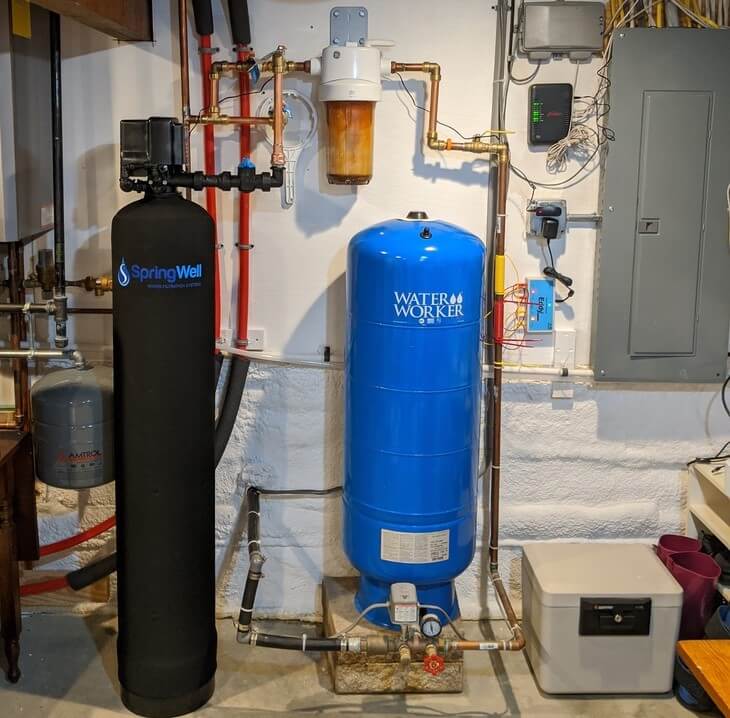
🚰 Chlorine Injection Iron Filter
Type of iron removed: Ferrous & ferric iron
Iron reduction rate: Up to 30 PPM
Chemical oxidation is another highly effective iron-removal solution and can remove up to 20-30 PPM of iron.
An advantage of using chlorine for oxidation is that it’ll also disinfect your water. It also tackles mild-to-moderate iron bacteria contamination – something that an air injection iron filter can’t do.
How it Works
A chlorine oxidizing system uses a feed pump to deliver a measured amount of chlorine – an effective chemical oxidizing agent – into water.
The water is held in a tank to give the chlorine time to take effect. Around 20 minutes of contact time is typically required for chlorine to oxidize the iron in water.
Once the iron has precipitated out of the water, a GAC (granular activated carbon) filter is used to capture the iron and the chlorine, so the water is iron-free and safe to drink.
Chlorine oxidation filters provide similar results to aeration water systems, but are less convenient, as you have to wait for the chlorine to take effect.
The Evidence
- The same 2016 comparative study on the different solutions for oxidizing iron and manganese in groundwater found that chlorine can remove up to 100% of iron.
- The use of chlorination to oxidize bacteria, followed by filtration to remove the iron particles, was recommended by Texas A&M University in a publication partially funded by the U.S. EPA.
Best For
People who want to remove both types of iron from their water as well as disinfecting it, or folks who want to treat an ongoing issue with iron bacteria.
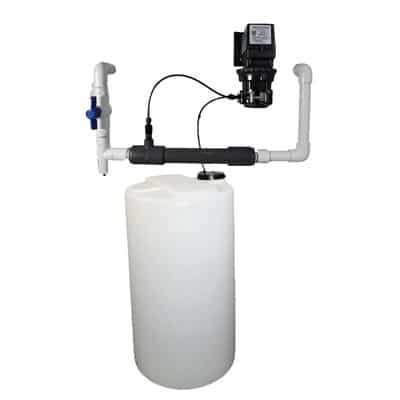
🪞 Ozone Water Treatment
Type of iron removed: Ferrous & ferric iron
Iron reduction rate: Up to 30 PPM
Ozone treatment is another common chemical oxidation method, following chlorine.
Like chlorine injection, ozonation also disinfects water, and can be used effectively to tackle iron bacteria in water supplies.
Ozone actually oxidizes water more effectively than chlorine, but ozone systems typically use more electricity and are more expensive.
How it Works
The ozone treatment process works by exposing raw water to ozone, causing the iron and other minerals to oxidize. A GAC filter is used to filter out the iron precipitate and ozone.
The Evidence
- A 2009 study on the removal of iron and manganese in simulated groundwater concluded that an ozone dose of 3 mg/L could effectively reduce up to 96% iron at the optimum temperature of 20°C (68°F).
- A 2012 study in Ozone: Science and Engineering found that iron was “very rapidly oxidized to an insoluble form” by ozone. But the study noted that these results were achieved in the absence of organic matter, and the presence of organic matter in the water prevented the iron from precipitating.
Best For
Folks with bigger budgets who want another effective chemical-based solution to oxidize iron, as well as tackling iron bacteria and disinfecting their water.
🧴 Hydrogen Peroxide Oxidation
Type of iron removed: Ferrous & ferric iron
Iron reduction rate: Up to 30 PPM
Hydrogen peroxide injection systems are rapidly becoming one of the most popular choices for iron removal because they’re highly reliable and effective.
Hydrogen peroxide, or H2O2, works better than oxygen to oxidize iron, and doesn’t produce as much iron sludge as other chemical methods.
How it Works
No contact time is needed for hydrogen peroxide treatment: a measured amount of H2O2 is injected into the water, which gets to work immediately.
The hydrogen peroxide oxidizes iron in the water, causing it to form a ferric hydroxide floc. A filter or clarifier can then be used to remove the floc from the water.
The Evidence
- A 2018 study on removing iron from water using hydrogen peroxide treated water with 0, 0.1, 1, 3, 5, 10 and 20 PM of hydrogen peroxide, concluding that 85%-96% of iron was removed on average at the normal pH range of drinking water.
- A study conducted in 2009 focused on using hydrogen peroxide to oxidize iron in underground water, and found that hydrogen peroxide was of “great practical value” and could be used with high efficiency for this purpose. The results were used to design and construct an underground water treatment station in Russia.
Best For
Anyone who wants to effectively and instantly oxidize iron in their water with a practical water treatment solution.
🧮 Potassium Permanganate Solution
Type of iron removed: Ferrous & ferric iron
Iron reduction rate: Up to 10 PPM
Another chemical compound used in oxidation systems is potassium permanganate. This inorganic compound combines manganese oxide ore with potassium hydroxide and is commonly used alongside manganese greensand media.
Potassium permanganate is usually effective at reducing up to 10 PPM of iron.
How it Works
This process involves a redox reaction where potassium permanganate is reduced, and iron ions in the water are oxidized, forming particles that are insoluble in water.
Next, the iron hydroxide precipitate is removed, usually through filtration or settling.
Carefully minoring and controlling the potassium permanganate dosage is essential to prevent over-oxidation and ensure the water quality remains desirable. This chemical is dyed purple for safety reasons and may linger in the manganese greensand bed, giving your water a pinkish tinge.
The Evidence
- A 2018 study on removing iron and manganese from groundwater supplies using potassium permanganate concluded that the method could remove up to 100% of iron at a pH of 7.
- A Journal of Water Supply study conducted 20 years prior in 1998 reported that potassium permanganate removed 79–99% iron in water supplies with a pH of 6.0–10.0 and an initial iron concentration of 3.5–10.0 mg/L.
Best For
People with up to 10 PPM of iron in their water who want a simple method of removing this contaminant and don’t mind using chemicals.
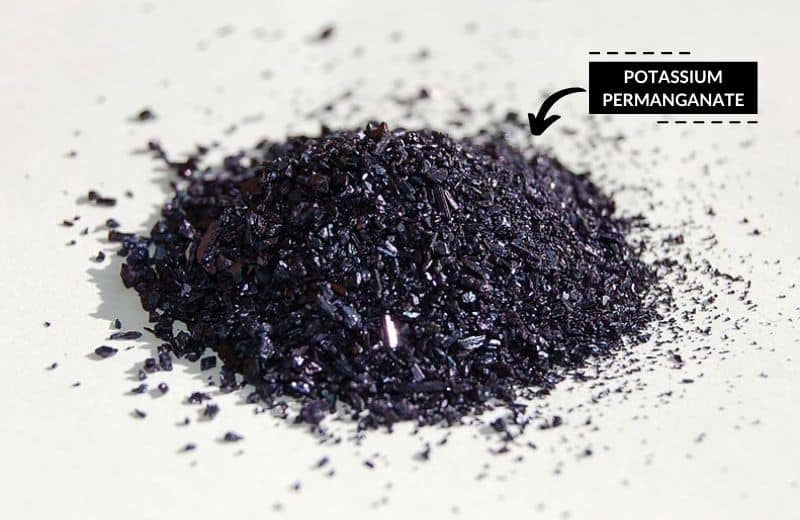
🔮 Polyphosphate Sequestering
Type of iron removed: Ferrous & ferric iron (best at treating ferrous iron)
Iron reduction rate: 3-4 PPM
You might also come across a number of iron removal systems that use polyphosphate as a chemical iron treatment method.
This chemical causes the iron to stabilize and disperse, preventing iron staining.
How it Works
As with the other chemical treatments, polyphosphate is injected into the water in the treatment system.
Unlike the other methods we’ve discussed so far, polyphosphates don’t rely on oxidation to remove iron. Instead, they use a sequestering mechanism. Polyphosphates bind with iron to form stable, soluble complexes, preventing it from precipitating and forming solid particles.
That means the iron is still present in the water supply but is unable to form rust when it comes into contact with air.
As with many of these iron removal water treatment methods, the effectiveness of polyphosphates can be influenced by factors like the water pH and the concentration of metal ions.
The Evidence
- Polyphosphates have been used in the water treatment industry for decades – in a 1957 evaluation of the use of polyphosphate in the water industry by the Illinois State Water Survey, these chemicals were presented as a solution to treat rusty water prior to being exposed to air and before chlorination. According to the report, the amount of polyphosphate needed to effectively remove iron is 2-4 PPM per 1 PPM of iron.
- A 2002 study on the effect of polyphosphates on iron concentrations in water noted that these chemicals reduced the color and turbidity of iron suspensions, effectively addressing iron precipitation and “related discolored water complaints”.
Best For
Folks who want to address the aesthetic issues caused by iron but don’t necessarily want or need to remove the mineral from their water supply.
⚗️ Birm
Type of iron removed: Ferrous & ferric iron
Iron reduction rate: 10-15 PPM
Birm is made from a natural material, usually pumice, coated with manganese dioxide.
The media is often used alongside an oxidizing treatment method, like an air injection system, but may also be used alone. It should last 4-8 years with regular backwashing cycles.
How it Works
As an insoluble catalyst, birm facilitates the reaction between iron and dissolved oxygen, enhancing the oxidation process. The birm then captures the oxidized iron particles and filters them out of the water.
Birm filters require minimal maintenance when they’re used under the right conditions.
However, there must be enough dissolved oxygen in water for birm’s iron removal media to work. Many birm systems require an air pump to increase the oxygen levels in water.
Plus, if you have manganese as well as iron, birm media isn’t the best solution – we recommend looking at manganese greensand instead.
The Evidence
- A 2019 study on the removal of iron from well water by different techniques concluded that birm could reduce 87.5% iron, making it more effective than greensand (which removed 71.8% iron) and zeolite (which removed 68.5% iron).
Best For
Using in combination with air injection iron filters to capture the insoluble iron and remove it from your water supply.
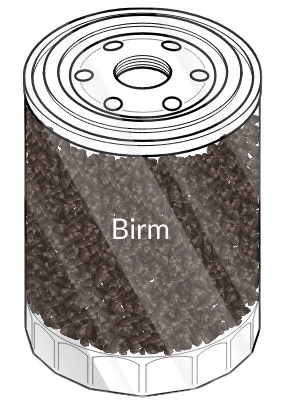
🈯️ Manganese Greensand
Type of iron removed: Ferrous & ferric iron
Iron reduction rate: 10-15 PPM
Manganese greensand filter systems are made with manganese dioxide-coated beads or pellets.
Like birm, greensand media is often used in combination with another type of water treatment – typically air injection – to remove oxidized iron from a water supply. But it can also be used as a standalone iron removal system.
How it Works
Manganese greensand is capable of oxidizing and filtering iron: the manganese oxide coating releases oxygen, which oxidizes the iron present in the water, and the media bed traps these oxidized particles until they’re removed by backwashing.
During backwashing, potassium permanganate or chlorine is used to clean the media bed, preventing clogging.
A water pH of above 7.5 is required for a properly functioning manganese greensand filter, and there should also be no tannins in the water.
The Evidence
- The same study on the removal of iron from well water by different techniques (which we mentioned when discussing birm media) noted that greensand removed 71.8% iron on average, making it an effective iron removal solution.
- Manganese greensand is also listed as a “basic treatment” for oxidizing iron in the Iron and Manganese Removal Handbook by the American Water Works Association, and several proprietary greensand media are mentioned.
Best For
Anyone who wants an effective, chemical-free solution to remove both iron and manganese from their well water.
Related: Iron Filters vs Water Softeners for Iron Removal: Do I Need Both?
💠 Katalox, Filox, & Pyrolox
Type of iron removed: Ferrous & ferric iron
Iron reduction rate: 10-15 PPM
There are several other media types that may be used in an oxidation system. Three media types made from manganese oxide are katalox, filox, and pyrolox.
Different media types of different iron removal abilities, but most media can remove around 15 PPM of iron.
How it Works
These media work by instigating a reaction between oxygen in the water and the dissolved iron, forming ferric hydroxide.
They typically have a large surface area and need daily backwashing to remove the accumulated iron particles.
Katalox, filox, and pyrolox are designed to oxidize dissolved iron, and if the water has low oxygen levels (meaning that it has a low redox potential), the water may need to be treated beforehand with an oxidant, like chlorine or air.
The Evidence
- A 2020 review of the characteristics and application of filter media for groundwater treatment listed fliox and pyrolox as two types of manganese ores that can be effectively used to remove iron. The authors also commented that these media are capable of removing hydrogen sulfide.
- Another review published in 2021 on the removal of iron from water using oxidation commented that pyrolox serves as a “strong catalyst to accelerate the oxidation of iron”, with a water pH of 6.5 to 9.0. However, a listed disadvantage of pyrolox is that it requires a high backwash flow rate.
Best For
Folks looking for chemical-free iron filters and don’t mind the increased backwash requirements of these media.
🔅 KDF Filters
Type of iron removed: Ferrous & ferric iron
Iron reduction rate: 4-6 PPM
KDF is a type of water filter that’s effective at removing iron in both soluble and insoluble forms, but is best for ferrous iron.
There are a few different types of KDF filters, and the best type for removing iron is KDF-85.
How it Works
A KDF water filter has a copper-zinc media and produces an electrochemical reaction that converts harmful contaminants into non-harmful, or removable, forms.
Because KDF is typically used in a filter cartridge, it’s a better choice for people who prefer to change a filter rather than deal with chemical top-ups and backwashing.
Most KDF filters can remove between 4 and 6 PPM of iron, so they’re not ideal for very high concentrations of ferrous iron.
KDF oxidizing filters are more effective when water flows through the media slowly, giving it more contact time with the media.
The Evidence
- A 2019 study looked at the use of KDF material to improve the filtration performance of multi-layer filters and commented that, with the addition of KDF, a multi-layer sand and gravel filter could remove 67% of iron (there’s no mention of what type of KDF filter was used here or exactly how much iron was in the water – we only know that there was 2 mg/L of heavy metals overall).
- A 2021 critical review of point-of-use drinking water treatment in the U.S. commented that KDF-85 is the most effective type of KDF for eliminating iron because the media acts as a catalyst to change soluble ferrous cations into insoluble ferric hydroxide
Best For
People who have lower concentrations of iron in their water and want a cartridge-based filter to remove this metal and improve their water quality.
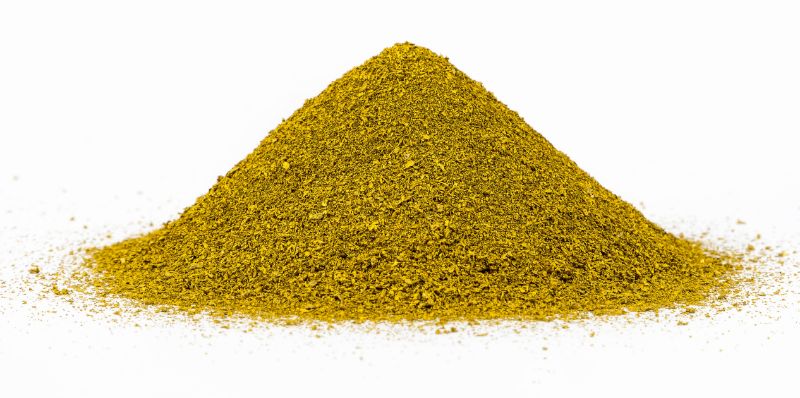
📇 Sediment Cartridge Filters
Type of iron removed: Ferric iron
Iron reduction rate: Up to 6 PPM
Sediment water filter products remove suspended sediment in water, like dust, sand, and rust.
You can use them to remove iron from well water in ferric form, which usually shows up as brownish-red flakes.
Most sediment filters can remove an average of 6 PPM of iron. If your ferric iron levels are any higher than 8 PPM, a sediment filter isn’t the best choice.
How it Works
Sediment filters use mechanical separation to trap iron particles in the filter media, allowing only water particles (which are smaller than the media pores) to pass through. The typical pore size for a sediment filter for ferric iron removal is 5-10 microns.
Soluble ferrous iron can’t be removed from sediment filters, as it’s dissolved in water, so it’ll pass straight through the filtration system with the water particles.
You might need several different sediment filter stages with different micron sizes to trap rust particles of various sizes. Plus, very high levels of ferric iron will clog the filter media quickly. If you have very large flecks of rust in your water, we recommend a spin-down sediment filter instead.
The Evidence
- We were unable to find any studies that specifically tested the ability of sediment filters to remove iron from well water. However, sediment filters are discussed in a 2013 University of Nebraska report for their ability to remove “sand, silt, loose scale, clay, or organic material from the water). Rust or ferric iron is considered inorganic because it doesn’t contain carbon.
Best For
Anyone with a rusty water supply who just needs to focus on removing ferric iron and not ferrous iron.
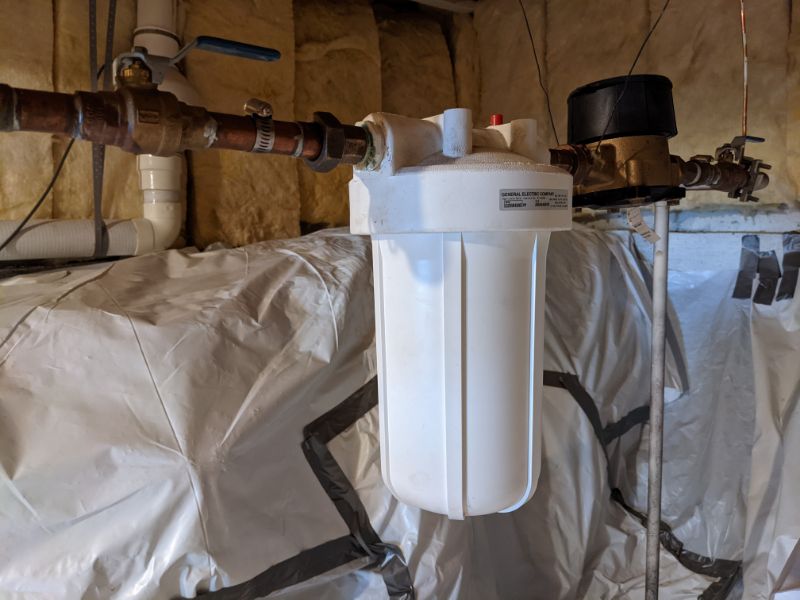
Related: The cheapest ways to remove iron from well water
🌀 Shock Chlorination
Type of iron removed: Bacterial iron
Iron reduction rate: Up to 100& iron bacteria
Iron bacteria, or bacterial iron, is a particularly tricky contaminant. Many of the methods of iron removal are incapable of removing iron bacteria.
Instead, methods of physical removal, then shock chlorination or chemical disinfection, are required. This is typically followed by chemical injection, which will kill bacteria and prevent iron bacteria formation in the long run.
How it Works
When you shock chlorinate a well, you introduce a high concentration of chlorine into the well system. Chlorine is a strong oxidizing agent, and disrupts the cell structure of iron bacteria, destroying their cellular membranes and enzymes.
Shock chlorination effectively kills existing iron bacteria and also helps prevent their regrowth by oxidizing and eliminating the organic material they feed on.
The chlorine residual can linger in the well water system, providing ongoing protection and preventing the iron bacteria from resurging.
👨🔧 It’s important to understand how to treat iron bacteria in well water if this is the problem you’re dealing with. We’ve shared the most effective ways to remove iron bacteria in this guide.
The Evidence
- Shock chlorination is recommended by most U.S. states and Canadian provinces for tackling bacterial iron in well water, including the Minnesota Department of Health, the Michigan Drinking Water and Environmental Health Division, and the Government of Newfoundland and Labrador.
- A guide to shock chlorination by the University of Nebraska-Lincoln also comments that shock chlorination can be used to deactivate a variety of “pathogenic and nonpathogenic microorganisms”, including bacterial iron, sulfur, and manganese.
Best For
Folks dealing with bacterial iron in their water who need an effective solution that can address this tricky-to-remove contaminant.
🧠 How to Remove Iron From Water: FAQ
Can iron be filtered out of water?
Yes, iron can be filtered out of water. However, it’s sometimes necessary to oxidize iron first before filtering it out of the water with a special media, like greensand or birm. The iron typically needs to change into a soluble form so that it can be removed from the water with a filtration media.
Can you completely remove iron from well water?
Yes, you can completely remove iron from well water with an effective water filtration solution like an air injection/oxidation filter. The best water filters for iron can remove up to 20 PPM of iron; some can even remove up to 30 PPM.
Do water softeners remove iron from water?
Yes, water softeners remove iron from water – but only up to 3-4 PPM of ferrous iron. If your water contains ferric iron (rust) or the water’s iron concentrations are higher than 4 PPM, you can’t rely on a water softener to address your contamination concerns. Go for a dedicated iron removal system instead.
What is the best filter to remove iron from well water?
In our opinion, the best filter to remove iron from well water is an air injection/oxidation system because it removes high concentrations of iron minerals (both ferrous and ferric) without the use of chemicals. This makes them easier to maintain and lower-risk than the systems that use a chemical feed pump.
What dissolves iron in water?
If you want to know what turns iron into soluble iron, we haven’t come across a water treatment system that can do this. Instead, there are systems that turn soluble iron into an insoluble form that can be filtered out of the water. Air injection/oxidation systems can do this, as well as chemical injection systems, like chlorination systems. Nothing actually causes iron to dissolve into nothingness – it has to be physically removed.
Does reverse osmosis remove iron?
Yes, reverse osmosis can remove iron from water, however RO should not be used as primary treatment for iron.


